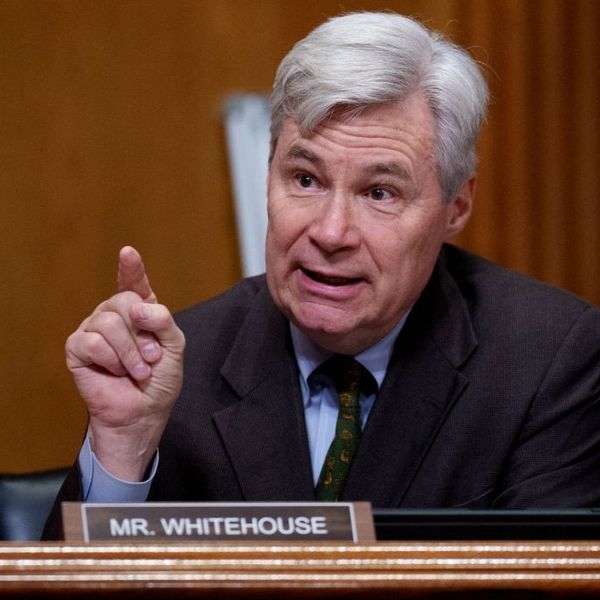In Hopeful Sign, EPA Slams State Department for 'Insufficient' KXL Review
Agency questions assumptions of 'inevitability' and calls for further review of greenhouse gas emissions
On the final day of the Keystone XL public comment period for the State Department's draft supplementary environmental impact statement (SEIS) of the Keystone XL tar sands pipeline, the Environmental Protection Agency issued a sharply critical assessment declaring the analysis "insufficient."
The EPA's objection is important, as the Washington Post explains, because it "not only provides opponents [of the pipeline] with political ammunition," it could also "force President Obama to directly weigh in on the permitting decision" if the EPA raises similar objections to a possible 'national interest determination' by the State Department.
"As long as no other agency objects," the Post continues, "State can issue a ruling on the pipeline on its own; if EPA challenges the national interest determination the State Department makes at the end of its review process, Obama himself would have to issue the final permit decision."
In a letter (pdf) to the State Department sent Monday, the EPA outlines detailed objections to the assessment of Transcanada's proposed pipeline project. The letter specifically questions the "inevitability" of the tar sands extraction, increased carbon pollution, additional energy associated with production, the difficulty of cleaning spilled bitumen and the environmental sensitivity of the proposed route.
"These findings by EPA help confirm what we have been saying all along," writes the NRDC's Elizabeth Shope. "The environmental review by the State Department is inadequate, and a proper environmental review for the risky Keystone XL tar sands pipeline showing the full risks to our land, air, water and climate from extracting, transporting and refining up to 830,000 barrels per day of dirty tar sands oil from Canada is not in our national interest."
Analyzing the letter, Shope continues:
EPA rates the environmental impact statement with a 2 - meaning "insufficient" - and rates the environmental impact of Keystone XL as "EO" for "environmental objections." EPA expresses serious concerns about the State Department's markets analysis - which State uses to claim that there would be no significant effect on greenhouse gas emissions. EPA also writes that the differences in tar sands diluted bitumen spills and conventional oil spills should be more fully addressed, and that they are "concerned... that the DSEIS does not provide a detailed analysis of the Keystone Corridor Alternative routes."
In 2011, the EPA expressed similar criticisms of the project.
Marking the end to the public comment period, grassroots environmental group 350.org celebrated the more than one million comments submitted to the US State Department by opponents of the KXL pipeline.
"It's going to take some time for State Department and the White House to go through a million comments, but when they do they'll see a common thread: people from every part of the country in every walk of life think that this pipeline is bad for our land, water and climate," said 350.org spokesperson Daniel Kessler.
"Families from Arkansas, Michigan, Nebraska and across the country have weighed-in in huge numbers urging President Obama and Secretary Kerry to reject Keystone XL," added Nebraska landowner Randy Thompson. "There is too much risk to trade away our health, our water and our land for a tar sands pipeline that benefits foreign oil companies. Momentum is building against the Keystone XL tar sands pipeline every single day."
_____________________
An Urgent Message From Our Co-Founder
Dear Common Dreams reader, The U.S. is on a fast track to authoritarianism like nothing I've ever seen. Meanwhile, corporate news outlets are utterly capitulating to Trump, twisting their coverage to avoid drawing his ire while lining up to stuff cash in his pockets. That's why I believe that Common Dreams is doing the best and most consequential reporting that we've ever done. Our small but mighty team is a progressive reporting powerhouse, covering the news every day that the corporate media never will. Our mission has always been simple: To inform. To inspire. And to ignite change for the common good. Now here's the key piece that I want all our readers to understand: None of this would be possible without your financial support. That's not just some fundraising cliche. It's the absolute and literal truth. We don't accept corporate advertising and never will. We don't have a paywall because we don't think people should be blocked from critical news based on their ability to pay. Everything we do is funded by the donations of readers like you. Will you donate now to help power the nonprofit, independent reporting of Common Dreams? Thank you for being a vital member of our community. Together, we can keep independent journalism alive when it’s needed most. - Craig Brown, Co-founder |
On the final day of the Keystone XL public comment period for the State Department's draft supplementary environmental impact statement (SEIS) of the Keystone XL tar sands pipeline, the Environmental Protection Agency issued a sharply critical assessment declaring the analysis "insufficient."
The EPA's objection is important, as the Washington Post explains, because it "not only provides opponents [of the pipeline] with political ammunition," it could also "force President Obama to directly weigh in on the permitting decision" if the EPA raises similar objections to a possible 'national interest determination' by the State Department.
"As long as no other agency objects," the Post continues, "State can issue a ruling on the pipeline on its own; if EPA challenges the national interest determination the State Department makes at the end of its review process, Obama himself would have to issue the final permit decision."
In a letter (pdf) to the State Department sent Monday, the EPA outlines detailed objections to the assessment of Transcanada's proposed pipeline project. The letter specifically questions the "inevitability" of the tar sands extraction, increased carbon pollution, additional energy associated with production, the difficulty of cleaning spilled bitumen and the environmental sensitivity of the proposed route.
"These findings by EPA help confirm what we have been saying all along," writes the NRDC's Elizabeth Shope. "The environmental review by the State Department is inadequate, and a proper environmental review for the risky Keystone XL tar sands pipeline showing the full risks to our land, air, water and climate from extracting, transporting and refining up to 830,000 barrels per day of dirty tar sands oil from Canada is not in our national interest."
Analyzing the letter, Shope continues:
EPA rates the environmental impact statement with a 2 - meaning "insufficient" - and rates the environmental impact of Keystone XL as "EO" for "environmental objections." EPA expresses serious concerns about the State Department's markets analysis - which State uses to claim that there would be no significant effect on greenhouse gas emissions. EPA also writes that the differences in tar sands diluted bitumen spills and conventional oil spills should be more fully addressed, and that they are "concerned... that the DSEIS does not provide a detailed analysis of the Keystone Corridor Alternative routes."
In 2011, the EPA expressed similar criticisms of the project.
Marking the end to the public comment period, grassroots environmental group 350.org celebrated the more than one million comments submitted to the US State Department by opponents of the KXL pipeline.
"It's going to take some time for State Department and the White House to go through a million comments, but when they do they'll see a common thread: people from every part of the country in every walk of life think that this pipeline is bad for our land, water and climate," said 350.org spokesperson Daniel Kessler.
"Families from Arkansas, Michigan, Nebraska and across the country have weighed-in in huge numbers urging President Obama and Secretary Kerry to reject Keystone XL," added Nebraska landowner Randy Thompson. "There is too much risk to trade away our health, our water and our land for a tar sands pipeline that benefits foreign oil companies. Momentum is building against the Keystone XL tar sands pipeline every single day."
_____________________
On the final day of the Keystone XL public comment period for the State Department's draft supplementary environmental impact statement (SEIS) of the Keystone XL tar sands pipeline, the Environmental Protection Agency issued a sharply critical assessment declaring the analysis "insufficient."
The EPA's objection is important, as the Washington Post explains, because it "not only provides opponents [of the pipeline] with political ammunition," it could also "force President Obama to directly weigh in on the permitting decision" if the EPA raises similar objections to a possible 'national interest determination' by the State Department.
"As long as no other agency objects," the Post continues, "State can issue a ruling on the pipeline on its own; if EPA challenges the national interest determination the State Department makes at the end of its review process, Obama himself would have to issue the final permit decision."
In a letter (pdf) to the State Department sent Monday, the EPA outlines detailed objections to the assessment of Transcanada's proposed pipeline project. The letter specifically questions the "inevitability" of the tar sands extraction, increased carbon pollution, additional energy associated with production, the difficulty of cleaning spilled bitumen and the environmental sensitivity of the proposed route.
"These findings by EPA help confirm what we have been saying all along," writes the NRDC's Elizabeth Shope. "The environmental review by the State Department is inadequate, and a proper environmental review for the risky Keystone XL tar sands pipeline showing the full risks to our land, air, water and climate from extracting, transporting and refining up to 830,000 barrels per day of dirty tar sands oil from Canada is not in our national interest."
Analyzing the letter, Shope continues:
EPA rates the environmental impact statement with a 2 - meaning "insufficient" - and rates the environmental impact of Keystone XL as "EO" for "environmental objections." EPA expresses serious concerns about the State Department's markets analysis - which State uses to claim that there would be no significant effect on greenhouse gas emissions. EPA also writes that the differences in tar sands diluted bitumen spills and conventional oil spills should be more fully addressed, and that they are "concerned... that the DSEIS does not provide a detailed analysis of the Keystone Corridor Alternative routes."
In 2011, the EPA expressed similar criticisms of the project.
Marking the end to the public comment period, grassroots environmental group 350.org celebrated the more than one million comments submitted to the US State Department by opponents of the KXL pipeline.
"It's going to take some time for State Department and the White House to go through a million comments, but when they do they'll see a common thread: people from every part of the country in every walk of life think that this pipeline is bad for our land, water and climate," said 350.org spokesperson Daniel Kessler.
"Families from Arkansas, Michigan, Nebraska and across the country have weighed-in in huge numbers urging President Obama and Secretary Kerry to reject Keystone XL," added Nebraska landowner Randy Thompson. "There is too much risk to trade away our health, our water and our land for a tar sands pipeline that benefits foreign oil companies. Momentum is building against the Keystone XL tar sands pipeline every single day."
_____________________

